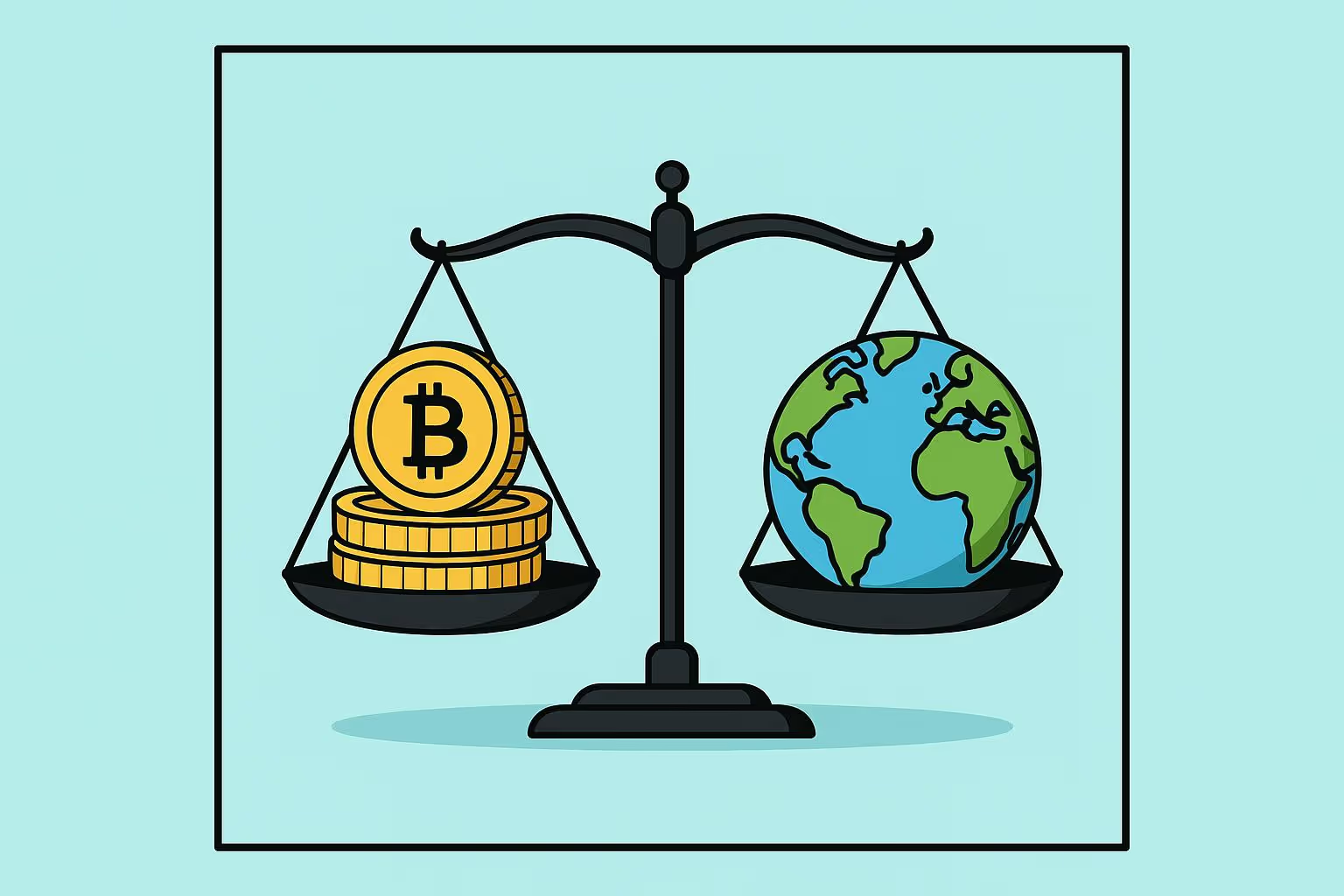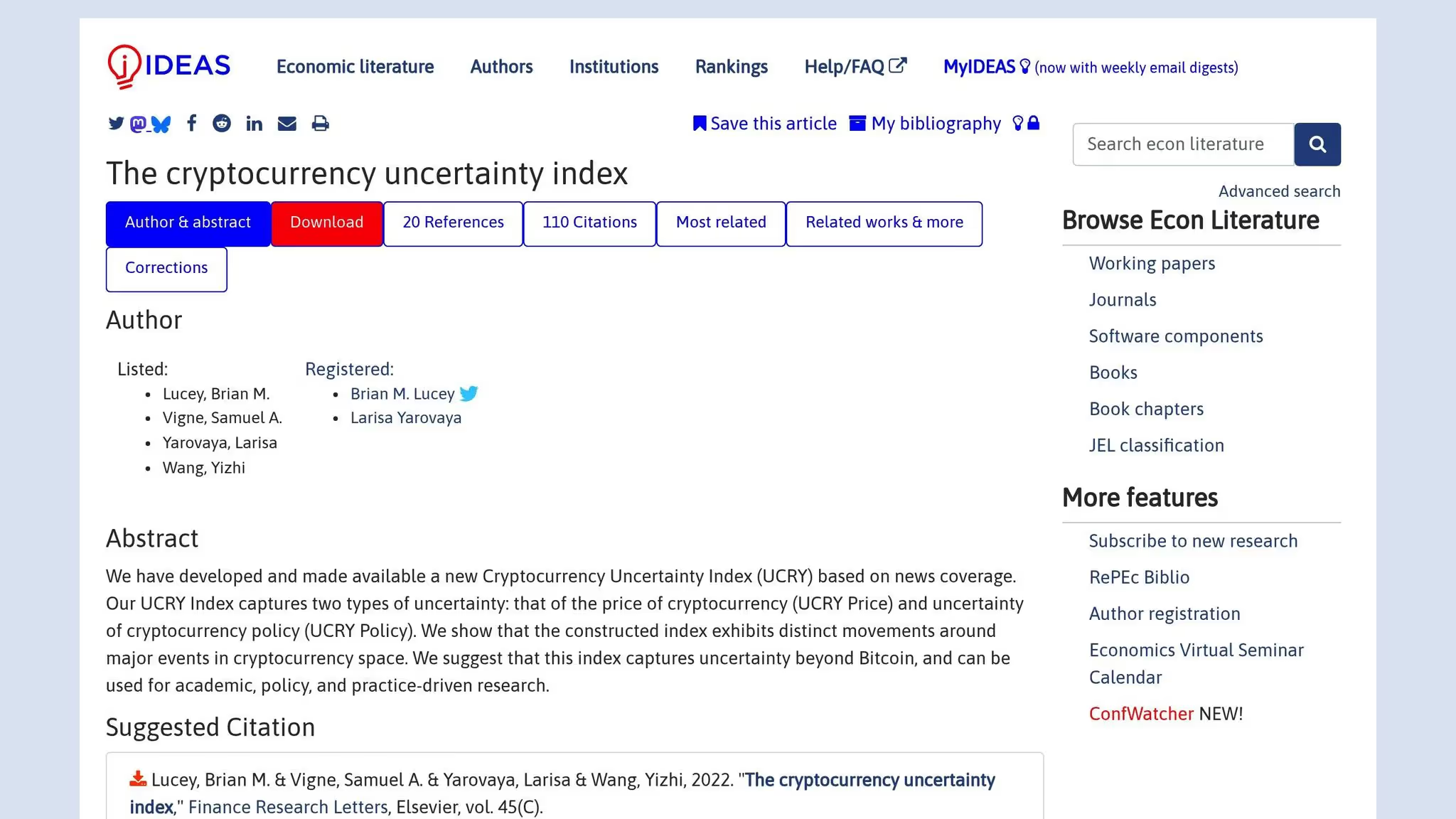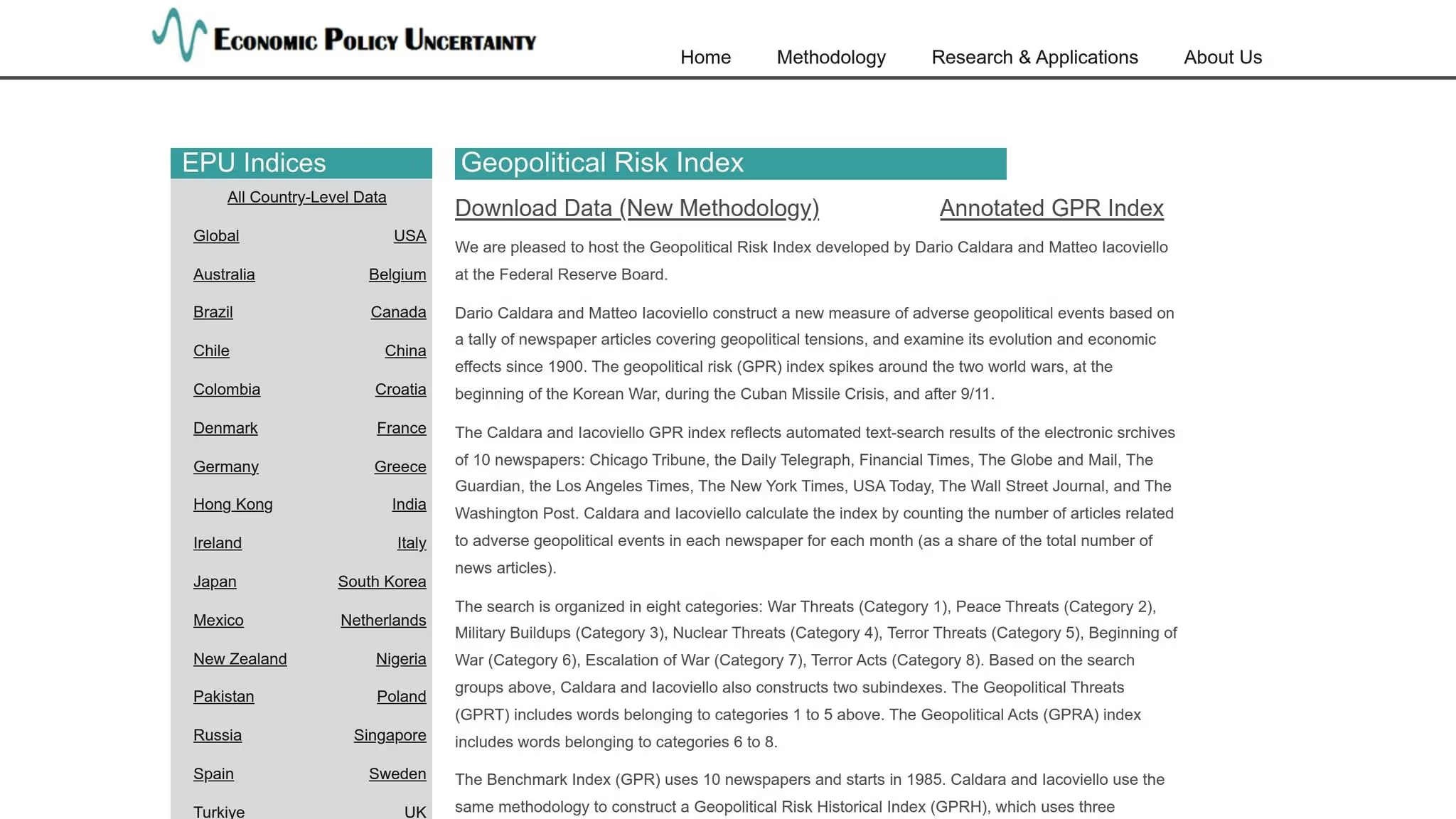Guide to Using a DeFi Tracker
Discover how a DeFi tracker transforms crypto portfolio management. Learn to track PnL, find smart money, and master your on-chain strategy.

November 22, 2025
Wallet Finder

November 7, 2025

Cryptocurrency markets react quickly to geopolitical events, often showing sharp price changes within hours. Unlike traditional markets, crypto operates 24/7, making it highly sensitive to global developments. Key takeaways include:
To navigate geopolitical volatility, traders should monitor real-time news, diversify portfolios, and leverage tools like Wallet Finder.ai for wallet and token analytics. These strategies help identify opportunities and manage risks effectively.
Key Tools:
Understanding these dynamics and using data-driven strategies can help traders make informed decisions during unpredictable market conditions.
Analyzing past geopolitical events can offer valuable trading insights. Here's a summarized checklist of key takeaways from these events.
The November 2024 election highlighted how political shifts can significantly impact crypto markets. Following the election, Bitcoin rose from $67,000 to over $100,000, while Ethereum jumped from around $2,400 to nearly $4,000. These sharp movements underline the market's sensitivity to political developments.
Beyond short-term price changes, elections have driven structural changes in the market. For instance, the approval of spot Bitcoin and Ethereum ETFs marked a regulatory turning point. BlackRock's iShares Bitcoin Trust alone saw net inflows exceeding $40 billion. Additionally, regulatory adjustments, like the easing of restrictive measures such as SAB 121, have encouraged institutional participation and boosted market liquidity.
While U.S. elections often spark regulatory optimism, geopolitical tensions in other regions bring different market dynamics to consider.
Trade disputes between the U.S. and China initially caused market volatility. However, crypto markets eventually stabilized, showcasing their ability to operate independently from traditional financial systems. For investors navigating decentralized finance, explore Top Tools for Monitoring Impermanent Loss to better track and manage the hidden risks that come with liquidity provision.
Conflicts in the Middle East often lead to sharp market corrections. As uncertainty fades, recovery phases emerge, presenting potential trading opportunities.
The Russia-Ukraine conflict demonstrated how geopolitical stress can reshape crypto markets. Initial uncertainty and market pressure gradually gave way to recovery. During this period, cryptocurrencies played a growing role in cross-border transactions, especially as traditional financial systems faced challenges. Stablecoins gained particular traction, with their market capitalization surpassing $200 billion by January 2025 - a year-over-year growth of more than 45%.
Geopolitical events bring both challenges and opportunities to crypto markets. Savvy traders use well-planned strategies to safeguard their investments and capitalize on market swings.
In times of geopolitical turbulence, markets can shift rapidly, often within hours of major announcements or conflicts. Staying informed is the first step to making smart trading decisions. Successful traders rely on multiple reliable information sources to anticipate market reactions.
Set up alerts from trusted financial and political outlets. Focus on events that historically influence crypto markets, such as elections, trade disputes, military tensions, or regulatory changes. Pay close attention to developments in key regions like the United States, China, and the European Union, as these areas often drive significant market movements.
Social media can provide early signals, but always verify information across multiple channels to avoid acting on misleading data. Historical patterns can also guide decisions - understanding how markets reacted to similar events in the past can offer valuable insights.
Quantitative tools like the Geopolitical Risk Index (GPR) and Cryptocurrency Uncertainty Index (UCRY) are especially useful. These indices measure market stress levels, helping traders identify whether cryptocurrencies are oversold or overbought due to geopolitical pressures.
Once you're informed, the next step is to protect your portfolio through diversification. Different cryptocurrencies respond differently to geopolitical events. For instance, Bitcoin often serves as a digital safe haven during economic instability, while altcoins can exhibit more dramatic price swings.
Diversification isn't just about spreading investments across various cryptocurrencies. Consider diversifying across asset classes and trading timeframes. Time diversification, such as dollar-cost averaging, can help reduce risk by spreading out investments instead of making large trades based on a single event. This approach can smooth out price fluctuations and lessen the impact of market timing errors.
Geographic diversification is another layer to consider. Cryptocurrencies with strong regional adoption may react differently to localized geopolitical events. For example, a conflict affecting European markets might not have the same impact on tokens popular in Asia or Latin America.
Data-driven decisions can give you the edge during volatile times. Platforms like Wallet Finder.ai provide real-time analytics, offering insights into how successful traders navigate uncertainty. By tracking wallet activity across Ethereum, Solana, and Base networks, the platform helps users identify profitable strategies.
Wallet Finder.ai allows traders to analyze metrics like realized PnL, win rates, and risk profiles, giving a clear picture of what works during different geopolitical scenarios. Telegram alerts notify users of significant wallet movements, enabling timely responses without the need for constant monitoring. You can customize alerts for specific wallet activities, token movements, or profit thresholds, ensuring you're always one step ahead.
The platform's token concentration analysis is particularly helpful in spotting trends. By examining how tokens are distributed among holders and tracking whale activity, traders can identify emerging opportunities before they gain widespread attention.
Additionally, Wallet Finder.ai's cross-chain analytics provide a broad view of how geopolitical events impact various blockchain ecosystems. While some networks may show resilience, others might face significant stress. This information helps traders allocate capital more effectively.
For those who value historical context, the platform's export capabilities allow users to analyze past data. By studying how markets responded to similar geopolitical events, traders can refine their strategies and be better prepared for future volatility.
Different asset classes react in unique ways when geopolitical tensions rise, offering valuable insights for shaping investment strategies.
Take Bitcoin, for instance. Often referred to as "digital gold", it tends to dip during market downturns but has a knack for bouncing back quickly - even in the face of geopolitical unrest. Gold, the classic safe-haven asset, usually gains traction during periods of instability, though its recent performance has been relatively subdued.
Traditional stocks, on the other hand, typically take a hit during crises. Defensive sectors can soften the blow, but broader market recoveries often rely on government stimulus measures. Meanwhile, the U.S. dollar tends to strengthen during global turmoil, while currencies from emerging markets, like the Russian ruble or the Ukrainian hryvnia, often weaken significantly.
Cryptocurrencies bring something different to the table - they operate 24/7, enabling borderless transactions even when traditional financial systems are disrupted. However, their close correlation with risk assets and ongoing regulatory challenges make them prone to sharp price swings. Altcoins, such as Ethereum, often experience even greater volatility than Bitcoin due to their smaller market sizes and diverse applications.
The growing institutional interest in cryptocurrencies has also changed the game. Companies have started adding Bitcoin to their balance sheets as part of their treasury strategies, signaling its increasing acceptance as a financial asset. Similarly, USD-backed stablecoins have proven their worth during currency crises, offering exposure to the U.S. dollar without relying on banks.
What sets cryptocurrencies apart is their accessibility. Unlike gold or stocks, they can be managed directly from a smartphone, which is a game-changer in areas with limited banking infrastructure.
Understanding these patterns can help you align your portfolio with your risk tolerance and investment horizon. These observations build on earlier strategies for navigating the complexities of geopolitical volatility.
When global events shake up traditional market dynamics, having the right tools becomes crucial for navigating the uncertainty. These analytical instruments help traders spot emerging patterns, measure market instability, and make better decisions, especially during geopolitical disruptions. They work alongside previously discussed strategies, offering real-time insights and quantifiable data to adapt to volatile conditions.

The Cryptocurrency Uncertainty Index (UCRY) serves as a specialized gauge for assessing volatility in the crypto market. By tracking price fluctuations, trading volumes, and asset correlations, UCRY provides a snapshot of market uncertainty unique to digital assets. When geopolitical tensions rise, an uptick in UCRY often signals potential market shifts or periods of temporary stabilization, offering traders a heads-up on what to expect.

The Geopolitical Risk Index (GPR) measures the frequency of media coverage on geopolitical tensions and evaluates their potential economic impact. While not exclusive to cryptocurrencies, GPR adds valuable context by showing how global events might ripple across multiple asset classes. Historically, higher GPR readings have been linked to increased market volatility and sell-offs. When combined with crypto-specific metrics like UCRY, GPR helps traders differentiate between short-term news-driven movements and longer-lasting geopolitical pressures.

Expanding on earlier strategies, Wallet Finder.ai delivers real-time analytics across major blockchains, such as Ethereum, Solana, and Base. This platform empowers traders to track wallet performance and uncover profitable strategies during periods of geopolitical instability.
With its wallet discovery feature, users can filter wallets based on realized profit and loss (PnL) or win percentages, spotlighting strategies that have proven effective in volatile markets. Real-time Telegram alerts keep traders informed of wallet movements as they happen, offering early signals of broader market trends.
The platform’s token concentration analysis provides insight into how tokens are distributed among holders, helping traders identify shifts in market dynamics during geopolitical upheaval. Additionally, its cross-chain analytics track capital flows between blockchain ecosystems, shedding light on how regulatory or geopolitical pressures influence market behavior.
For those looking to refine their strategies, Wallet Finder.ai’s export functions allow users to backtest data against historical disruptions. This feature provides a solid, data-driven foundation for making informed decisions in future market scenarios.
The cryptocurrency market's reaction to geopolitical events is anything but straightforward. While economic crises often lead to positive returns for cryptocurrencies, political crises tend to have the opposite effect. Bitcoin's behavior, in particular, is highly influenced by the nature of the crisis - whether it’s health-related or geopolitical - and the scale of the event, with global conflicts creating different market dynamics than regional tensions.
Studies indicate that digital assets don’t consistently act as safe havens. Their effectiveness in providing protection depends largely on the specific type of crisis.
To navigate future geopolitical uncertainties, traders can benefit from combining historical insights with advanced analytical tools. Leveraging resources like the Cryptocurrency Uncertainty Index and Wallet Finder.ai offers real-time analytics that are essential for making informed decisions. These tools, paired with a strong risk management framework, help traders stay ahead in volatile markets.
One clear lesson from past events is that flexibility beats rigidity every time. As markets evolve, geopolitical situations change, and new crises emerge, traders who adapt by using historical data alongside current analytics are better positioned to turn volatility into opportunity rather than risk. By embracing these strategies, traders can stay aligned with shifting market dynamics.
Looking ahead, as digital assets become more integrated into global finance, geopolitical pressures are likely to increase. Those who learn from past patterns, stay vigilant to emerging trends, and maintain a flexible approach will have the best chance of thriving in the ever-changing landscape of cryptocurrency trading.
Geopolitical events can impact Bitcoin and altcoins in strikingly different ways, particularly when it comes to price volatility. Bitcoin often sees its volatility decrease during periods of heightened geopolitical tension, especially if its price remains relatively steady. Altcoins, however, tend to experience more dramatic price swings, largely due to their smaller market sizes and lower liquidity.
Altcoins are especially vulnerable to external shocks; even modest trading activity can lead to noticeable price shifts. Bitcoin, by contrast, is shaped more by overall market sentiment and its reputation as a potential 'safe haven' asset. This unique role often results in more nuanced or tempered price movements. Understanding these dynamics is critical for anyone navigating the crypto market during global uncertainties.
To navigate risks during geopolitical crises, traders should prioritize portfolio diversification, distributing investments across various asset classes. This approach minimizes reliance on a single market and reduces vulnerability to sudden shifts. Additionally, employing hedging strategies - such as futures, options, or other derivatives - can offer protection against abrupt market declines.
Keeping up-to-date with global developments and their potential ripple effects on crypto markets is equally important. Analytical tools can assist in tracking market trends, evaluating risks, and taking timely action. Platforms like DeFi wallet trackers are particularly useful, offering insights into wallet activity and trading behaviors, enabling traders to make informed decisions even during turbulent times.
WalletFinder.ai equips traders with the tools they need to tackle market volatility head-on. With its real-time insights into wallet activity and trading patterns, it becomes an invaluable resource during times of geopolitical uncertainty. By analyzing the data, users can pinpoint profitable opportunities and adjust their strategies with precision.
The platform keeps traders in the loop by monitoring key market shifts and delivering actionable alerts. This means you can stay ahead of the curve and make informed decisions, even when market conditions take unexpected turns.
{"@context":"https://schema.org","@type":"FAQPage","mainEntity":[{"@type":"Question","name":"How do geopolitical events impact Bitcoin's volatility compared to altcoins?","acceptedAnswer":{"@type":"Answer","text":"<p>Geopolitical events can impact Bitcoin and altcoins in strikingly different ways, particularly when it comes to price volatility. Bitcoin often sees its volatility decrease during periods of heightened geopolitical tension, especially if its price remains relatively steady. Altcoins, however, tend to experience more dramatic price swings, largely due to their smaller market sizes and lower liquidity.</p> <p>Altcoins are especially vulnerable to external shocks; even modest trading activity can lead to noticeable price shifts. Bitcoin, by contrast, is shaped more by overall market sentiment and its reputation as a potential 'safe haven' asset. This unique role often results in more nuanced or tempered price movements. Understanding these dynamics is critical for anyone navigating the crypto market during global uncertainties.</p>"}},{"@type":"Question","name":"How can traders manage risks in the crypto market during geopolitical crises?","acceptedAnswer":{"@type":"Answer","text":"<p>To navigate risks during geopolitical crises, traders should prioritize <strong>portfolio diversification</strong>, distributing investments across various asset classes. This approach minimizes reliance on a single market and reduces vulnerability to sudden shifts. Additionally, employing <strong>hedging strategies</strong> - such as futures, options, or other derivatives - can offer protection against abrupt market declines.</p> <p>Keeping up-to-date with global developments and their potential ripple effects on crypto markets is equally important. Analytical tools can assist in tracking market trends, evaluating risks, and taking timely action. Platforms like DeFi wallet trackers are particularly useful, offering insights into wallet activity and trading behaviors, enabling traders to make informed decisions even during turbulent times.</p>"}},{"@type":"Question","name":"How can Wallet Finder.ai help traders manage market volatility during geopolitical events?","acceptedAnswer":{"@type":"Answer","text":"<p>WalletFinder.ai equips traders with the tools they need to tackle market volatility head-on. With its real-time insights into wallet activity and trading patterns, it becomes an invaluable resource during times of geopolitical uncertainty. By analyzing the data, users can pinpoint profitable opportunities and adjust their strategies with precision.</p> <p>The platform keeps traders in the loop by monitoring key market shifts and delivering actionable alerts. This means you can stay ahead of the curve and make informed decisions, even when market conditions take unexpected turns.</p>"}}]}
"I've tried the beta version of Walletfinder.ai extensively and I was blown away by how you can filter through the data, and the massive profitable wallets available in the filter presets, unbelievably valuable for any trader or copy trader. This is unfair advantage."
.avif)
Pablo Massa
Experienced DeFi Trader